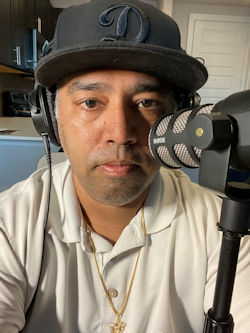SEJournal Online is the digital news magazine of the Society of Environmental Journalists. Learn more about SEJournal Online, including submission, subscription and advertising information.
Feature: Environmental Podcasting 101, Pt. II — Gear Up and Host Smartly
By Parimal Rohit
Welcome to the second of a three-part series on starting your own podcast, brought to you by SEJournal’s own in-house radio experts, podcaster Parimal Rohit, our Inside Story co-editor, who wrote the series, and Karen Schaefer, our Freelance Files co-editor, who conceived and edited it. Last week, Part I got you thinking about the kind of podcast you want. This week, Part II will help you understand the gear you need to produce podcasts and offer thoughts about hosting and structuring it. And next, Part III will get you going on marketing/promotion and fundraising for your podcast. Enjoy and feel free to email us at SEJournaleditor@gmail.com to let us know how you liked the series and if you’d like to see more similar features in the future. And in the meantime, be sure to check out SEJ.org's growing list of environmental podcasts. — The Editors
Once you figure out your podcast idea, you have to decide how you’ll actually execute it.
 |
| The author, podcaster Parimal Rohit. Click to enlarge. |
We’re still in a global pandemic as I write this how-to, so producing your podcast at home is probably the ideal way to go. Production can be quite simple, especially if you are hosting your podcast by yourself. Just connect your equipment to your computer and record (more on that below).
For recording at home, find a quiet corner where you can set up your computer and microphone (and interface, if you have one). Ideally, you’ve set up your microphone with a wall in front of you and your computer/podcast setup. This helps control the sound.
You should also be able to easily record with multiple people, but that means the added layer of coordinating with everyone. What equipment is everyone else using, if they are using anything at all? Are you all in the same room? Are you all remote and appearing virtually?
You’ll have to organize all of this with each episode.
Affordable technical setup options are many
There are plenty of affordable options when it comes to audio interfaces, the devices that help you get your sound in and out of your computer digitally.
I’ll avoid the technical aspects of equipment — that’s a separate tutorial, in and of itself. Instead, I’ll mention some of the best interfaces you can use. Each of these is user-friendly, which is why we can avoid a bogged-down discussion on technical operations.
I use the Zoom U-24 Handy Audio Interface. It’s light and compact. And it’s set up for two people to use it at the same time, so is great for shows that have two hosts. The U-22 interface is recommended for one-person shows. The U-44 is great for four people (with all in the same room).
In addition to the interface, you have to buy a dynamic microphone. Zoom products come with a USB cable and access code for Ableton Live 9 Lite editing software. And don’t forget to buy a power supply.
 |
| A stripped-down home studio recording setup with a laptop, USB microphone and headphones. Photo: Subhashish Panigrahi, Wikimedia Commons. Click to enlarge. |
Budget-wise, I spent about $150 for my Zoom U-24 interface and also purchased a Rode microphone, which I really like, for an additional $100.
There are high-end interfaces, such as the Rode RODECaster, which will cost you about $600. A second, more advanced RODECaster can set you back $1,300, but that includes four microphones, four headphones and a high-end interface. This package is ideal for those who have operated podcast or broadcast equipment for years.
Other affordable brands include Blackmagic, Focusrite and Behringer. Most interfaces will cost you between $150 and $300. Accessories will cost you an additional $150, at least.
If you want to go basic — say, a microphone and a computer — you can simply buy a podcast microphone and connect it to your laptop or desktop. You can find a Blue Yeti microphone, with USB, at Best Buy or on Amazon for $129.99. A Rode PodMic will cost you about $100. On the higher end are Shure microphones, which can cost you upwards of $250.
Are there other people appearing on your podcast? Consider hosting your podcast episode on one of the following services: Zoom, Microsoft Teams, Buzzsprout, SquadCast or the one I use, Simplecast.
These software programs are also effective for recording and/or editing: Audacity, Adobe Audition, GarageBand, Hindenburg (note that SEJ members get a discount), Logic Pro, Pro Tools and REAPER.
Each of these services might be an added cost, depending on whether you purchase a license and how you use them. For example, I purchased a Zoom subscription so I could record episodes for longer than 45 minutes.
For production, think structurally
But more important than all the technology, is the structure of your episodes and overall program. You have to first organize and establish the following:
- How long is each episode?
- How is each episode formatted?
- Are you creating seasons? How many episodes in a season?
- If you’re continuously releasing episodes, how frequently? Daily? Weekly? Monthly? Bimonthly? Quarterly?
Episodes should be five to 15 minutes, if you’re keeping it simple. Perhaps you’re simply providing digestible environmental news updates. If you’re doing a Q&A episode, consider having your episodes run 30 to 45 minutes, which is also ideal for news analysis.
More in-depth reporting can be 45 to 60 minutes. Perhaps you’re deep-diving into the harmful repercussions of the Texas winter storms this February. You might need 50 or 60 minutes to look, for instance, into how lower-income neighborhoods were adversely affected.
Your episodes are ideally capped off at one hour. So, if you have five hours of reporting to present, consider breaking it down to five or six episodes (or more, depending on episode length).
Consider themes, arcs
If you are doing seasons, consider each season covering a specific theme. (Each of your episodes, in general, should be as specific as possible, regardless of the number of episodes.)
Each episode should have its own arc. If you’re doing seasons, the entire season should have an arc, as well, in addition to the individual episode arcs.
Let’s say you’re doing episodes on the struggle of Louisiana fisheries to operate during the COVID-19 pandemic. Your episodes should focus on specific case studies, detail the struggles during the pandemic, maybe discuss the current state of the market, find experts to forecast the future of the industry, determine if there is any legislation to assist the fishers and — at the end — discuss realistic solutions.
You must do more than just say fishers are struggling, for example. Why does it matter, how is it relevant, what is the struggle and what are people doing about it?
Each episode should be both specific
and revelatory. What are you revealing
that no one knew before listening?
Also, as mentioned earlier — be revelatory, not encyclopedic. Each episode should be both specific and revelatory. What are you revealing that no one knew before listening to your podcast? What are you presenting that isn’t already out there (via Google search or otherwise common knowledge)?
One great example of a seasonally episodic podcast is Slate’s Slow Burn. The podcast’s first season delved into Watergate and Richard Nixon. Season two was about Bill Clinton and Monica Lewinsky. The third season highlighted the careers of Tupac and Notorious B.I.G. Each episode presented in this season offered perspectives we didn’t already know about the characters.
Another great example is ESPN’s 30-for-30 podcast series. My personal favorite topic was Ramona Shelburne’s five-episode podcast series on former L.A. Clippers owner Donald Sterling.
Hosting efficiently
OK. You’ve perfected your idea. Podcast equipment purchased. Production is underway. You’re now creating your podcasts.
But keep in mind: Hosting your own podcast episodes about what officials are doing about the nuclear generating station off the coast of San Diego County is not the same as writing a 3,000-word report on the same subject.
Podcasting is about efficiency: get to the point and get to it fast. Then analyze your point in as few words as possible — try to avoid long monologues, if possible. Once you’ve made and analyzed your point, move on to the next.
If you are interviewing someone, make your interviews conversational. Ask short questions initially. It’s better to ask three short questions on one through-line instead of one long question. You never want to be in a position where it takes longer to ask the question than it does to answer. I once had a co-host spend 45 seconds asking a question, which yielded a seven-second response. That’s not good for podcasting.
You also don’t want the question to be so long the interviewee has to ask you to repeat it, because he or she got lost before you finished.
Find your art of question-asking and you’ll be able to get to all the things you want to cover. Less is more. Maintain focus and the discussion will be engaging enough to keep the interviewee — and the audience — tuned in.
Also, always remember your arc. You can allow an interview or discussion to breathe, but don’t stray too far from your episode path. Know the end goal, and keep bringing the discussion, whenever it meanders, back to the path toward that goal.
Check out Part III on podcast marketing/promotion and funding.
Parimal Rohit is a veteran journalist currently serving as staff writer for the Austin Business Journal and podcaster with The Asian Highway. He hosts two podcasts: Erased, an environmental news podcast that launched in March 2021 (you can follow the show on Twitter at @ErasedEnvironment), and Storytellers in Action. He is also the producer of The Brown Table-A Bollywood Podcast. Previous stops include The Log (recreational boating publication), India-West (ethnic media), Mirror Media Group in Santa Monica, The Signal in Santa Clarita and Buzzine Networks in Hollywood. Rohit also covered sports, politics and entertainment as a freelancer for several publications, including Campus Circle and Sun Community Newspapers. He currently co-edits SEJournal’s Inside Story column, is a member of the SEJ Awards Committee and is editor of the upcoming Covering Your Climate-Southwest special report.
* From the weekly news magazine SEJournal Online, Vol. 6, No. 13. Content from each new issue of SEJournal Online is available to the public via the SEJournal Online main page. Subscribe to the e-newsletter here. And see past issues of the SEJournal archived here.













 Advertisement
Advertisement 



